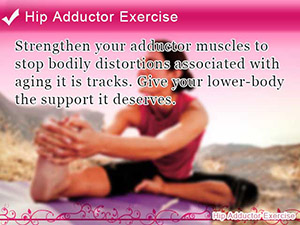The diet scene in Japan quickly picked up on the importance of strong hip adductor muscles in preventing deformity in your legs and pelvic area, leaving only your beautiful figure to do the talking. Here are exercises that real Japanese women are doing to keep their hips in check.
For many dieters, the thigh area is an area of the body that doesn't need to be called to attention. Women big and small suffer from the anxiety brought upon by thigh, hip, and leg problems. Wouldn't it be nice if there was something you can do about it?
So matter what you try, those hips just don't get any smaller. Well, have you tried strengthening your hip adductor muscles yet?Just by strengthening this one muscle group can you tighten down the area of your thighs, reduce back pain, and prevent bow legs, for a slimmer figure below the waist. Here's how you can do it too!
Quick Prevent Bow Legs and Knock Knees doing hip adductor training (Illustrated)
Hip adductor muscles self-check
Watching TV and observing the internet market, you may have heard of how you can fix deformity in your legs such as bow legs and how these conditions are related to the weakening of your adductor muscles in your hips. Here is a simple methods used to determine if your adductor muscles are weakening. As an added plus, by strengthening your hip adductor muscles you can slim down your thighs.
How can I tell if I need to flex my adductors more?
The weakening of your hip adductor muscles is often associated with bow legs and body bellies, i.e. the destruction of your once beautiful body line. That is why to protect your body line, building support in your hip adductor is a must. Let's check and see how your adductors stand against this test.
1. Sit down in a chair
By putting yourself in a sitting position you are ready to carry out this test, determine if you hip adductor muscles are weakened to prevent bow legs.
2. Look at your feet (Do you notice anything strange?)
When the strength in your adductor muscles decreases, it is said to be difficult to bring your knees together while sitting down. It is common among people who cross their legs to have weakened adductor muscles. That is why how you sit can weaken you adductor muscles.
In your sitting position, are your knees being held apart?
The best way of sitting is if from your butt to your toes a straight line forms between your body. If you can do this, then it's a sure sign that your hip adductor muscles are intact.
3. Time yourself
Bringing your knees, ankles and toes together, check how long you can keep you your legs together. If you feel like you have springs between your legs, then this is a sure indicator that you are not using these muscles on a regular basis.
What's causing your legs to start shaking when you are sitting down?
That's right; your body could use some hip adductor training. With adductor training you will be able to hold this position without having your legs shake like it's cold out.
4. If you have weak hip adductor muscles...
Whenever you get a sit, try sitting with your thighs, knees, and feet together. Sitting this way is a good way to strengthen your hip adductor muscles.
Slim down your hips! Adductor training lessons
The group of muscles lining your inner thighs is known as the adductor muscles. The individual muscles that make up this group consist of adductor longus, adductor brevis, adductor magnus, gracilis, and the pectineus. These muscles are responsible for balancing your pelvis.
Here are some joint and adductor exercises to get you started.
Hip adductor training – Lesson 1
1. Lay down on your side on the floor
Place one hand in front of your body to maintain balance and another to support you head as you lay down. Place one leg over the other balancing your body the same way as the hand placed on the floor.
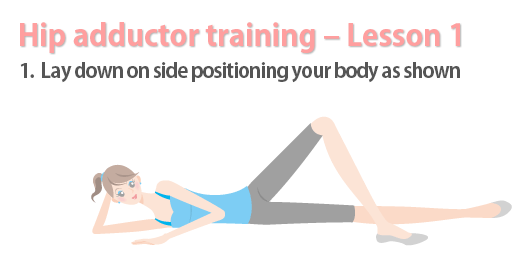
2. Raise the leg adjacent to the arm supporting your head (Exhaling as you move your leg into an upward position)
When you do this refrain from jerking your leg up to fast as to finish the exercise as fast as possible, but instead take your time while give yourself about 3 seconds time to go through the motions slowly.
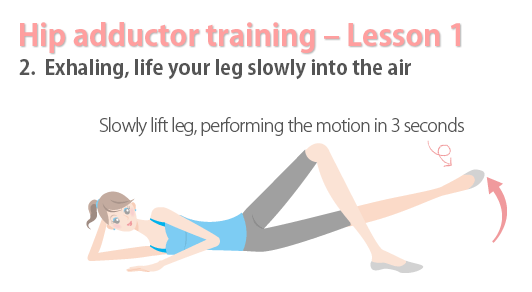
3. Stretch the joints in the back of your knees in the raised foot
Turn your foot at your ankles pointing your heal upward and hold for 3 seconds.
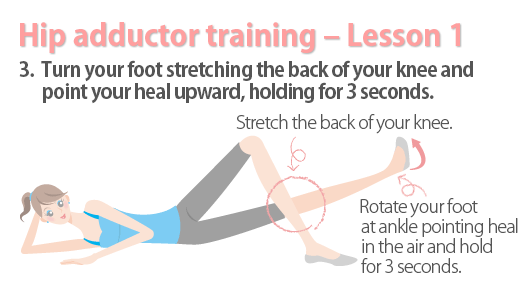
4. After holding for 3 seconds, inhale while lowing your leg
Bring your foot back down to the floor, stopping slightly before reaching the floor.
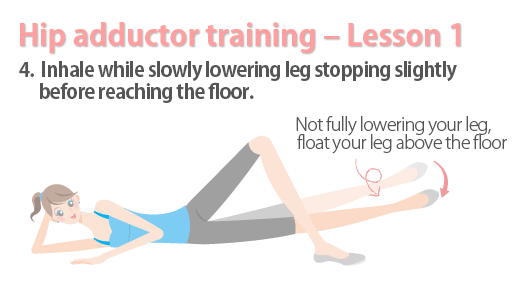
Repeat the movements in this exercise 5-10 times per set alternating legs. A good rule of thumb is to do as much as 3 sets per day for best results.
It's important to take special care in making sure your posture and hip position are upright during the exercise. Force your hips slightly forward such not to bend at the waist.
If necessary you can stretch out the leg above the leg you will be raising; however make sure that this movement does not affect the movement of your other leg.
Hip adductor training – Lesson 2
1. Straighten you back, bring your feet together into a butterfly position
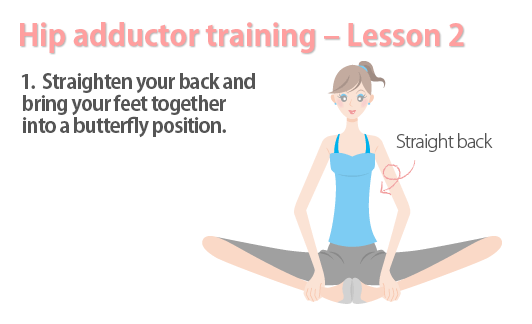
2. Place one leg in front of your body, stretching fully outward, pulling in the opposite towards your groin area.
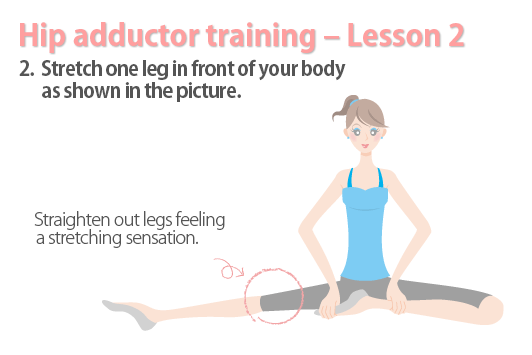
3. Stretch focusing on you stretching out your hip adductor muscles.
Straight back stick out your chest and hold for 10 seconds.
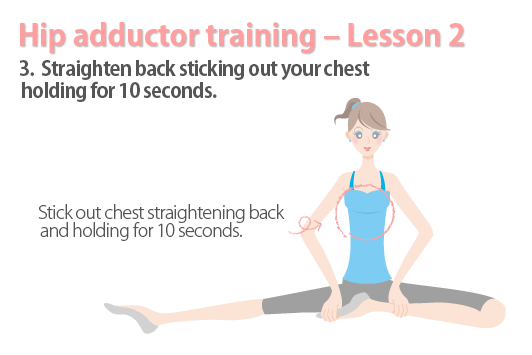
4. Switch sides and do it on your other leg
By grabbing the tips of your toes you begin to feel the stretch come towards the back of your thighs. Even if you are not grabbing the tips of your toes, bending at your knees a little is also effective.
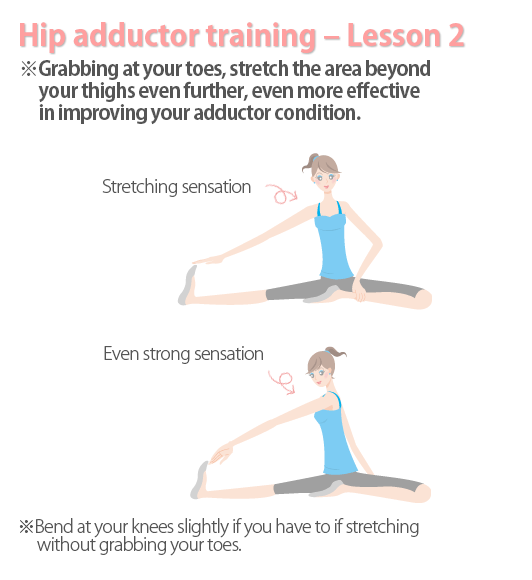
Although not as difficult as the exercise described in lesson 1, just breathing in itself should be enough to be considered a workout.
Hip adductor training – Lesson 3
- Prepare a chair. Sit down back straight with knees, ankles, and heels together.
- Place hands between thighs as if to grab hold
- Using your hand that you've placed between your thighs, apply pressure to the outside
Don't put so much pressure such to cause your hips tot spread apart. Put as much pressure on your thighs such as not to cause thighs to open up. - While pushing your legs feet open, keep your feet closed using your legs, add stamping to the routine
When stamping and your tiptoes reach the floor, alternatingly allow your heels to do the same. Do the exercise at your own pace until you get used to it. Once use to the exercise increase repetitions to about 30 times each time.
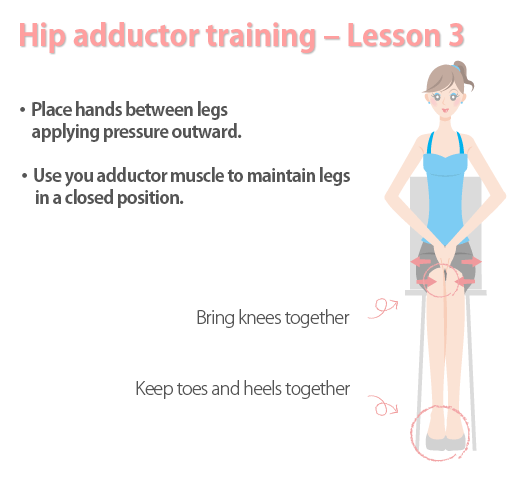
What happens when your adductor muscles become weakened?
The adductor muscles are used by your body to keep your legs closed together from your hips to the femur bones in your thighs. When you adductor muscles have weakened, your legs start to turn in outward. This is often the cause to bow legs. Women are particular wary that this condition will take away the attractiveness in their legs.
In addition, weakened adductor muscles could lead to the opening of your pelvic area. This causes your hip joints to turn outward. This condition is referred to as pelvic distortion, deformation in bond structure resulting from weakened supporting skeletal muscle.
However, by training your adductor muscles it is said that you can prevent lower back pain and bow legs. By strengthening your adductor muscles you can rid the symptoms to pelvic distortion and keep straight as your stand. Moreover, it's important to keeping your knees together producing a clean figure that you can be confident about yourself.






